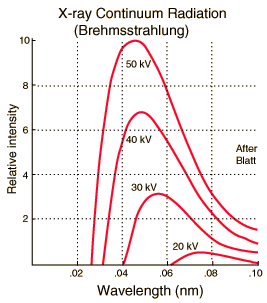X-Rays: Brehmsstrahlung radiation
Accelerated charges give off electromagnetic radiation, and when the energy of the bombarding electrons is high enough, that radiation is in the x-ray region of the electromagnetic spectrum. It is characterized by a continuous distribution of radiation called continuous x-ray spectrum which becomes more intense and shifts toward higher frequencies when the energy of the bombarding electrons is increased. A projectile electron can lose any amount of its kinetic energy in an interaction with the nucleus of a target atom, and the bremsstrahlung radiation associated with the loss can take on a corresponding range of values. For example, an electron with kinetic energy of 70 keV can lose all, none, or any intermediate level of that kinetic energy in a bremsstrahlung interaction; the Bremsstrahlung X-ray produced can have an energy in the range of 0 to 70 keV. Here, 70 keV is the energy that corresponds to the cut off wavelength (smallest wavelength - highest frequency therefore the highest possible energy - use E=hf=hc/l to calculate it). This is different from the production of characteristic x-rays that have specific energies.
|
Follow me...
|






